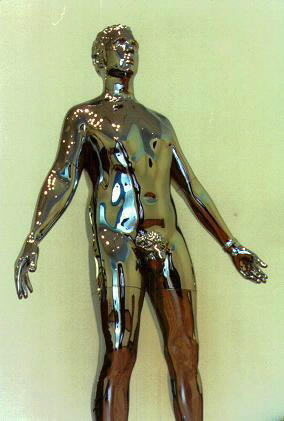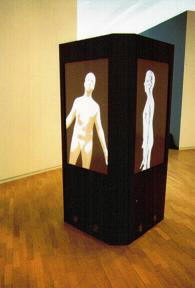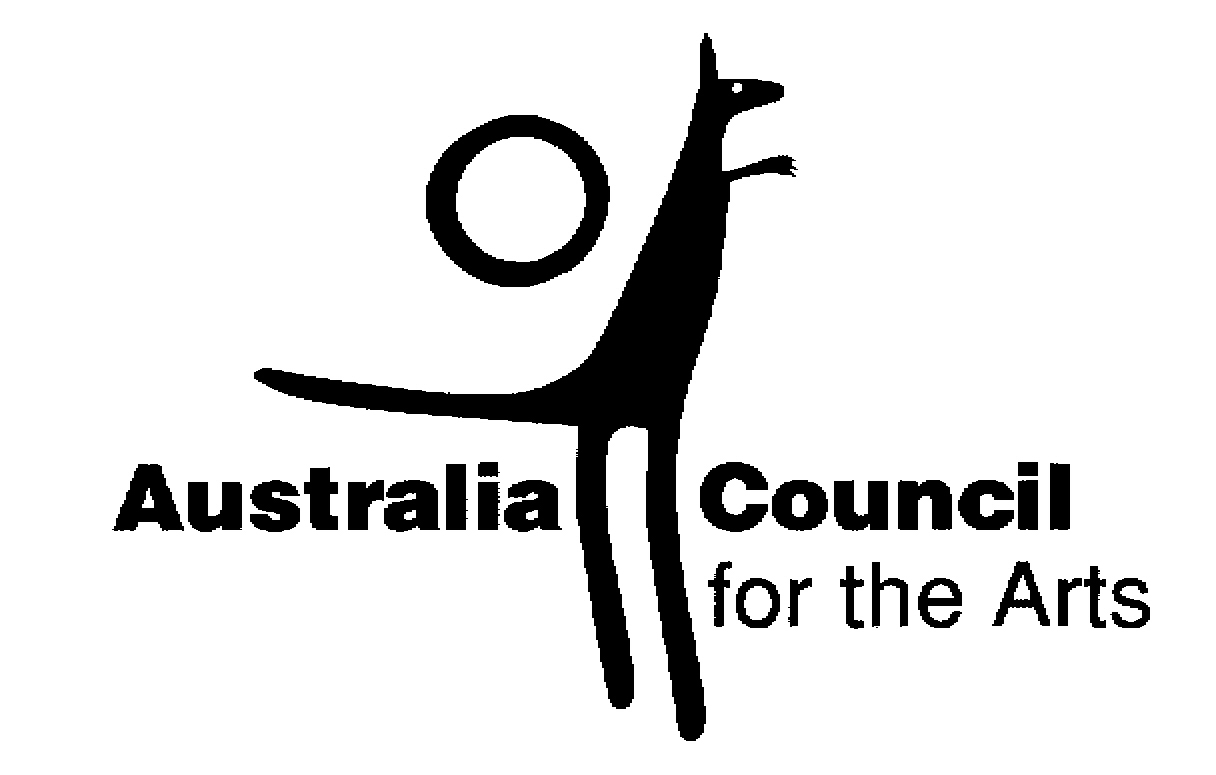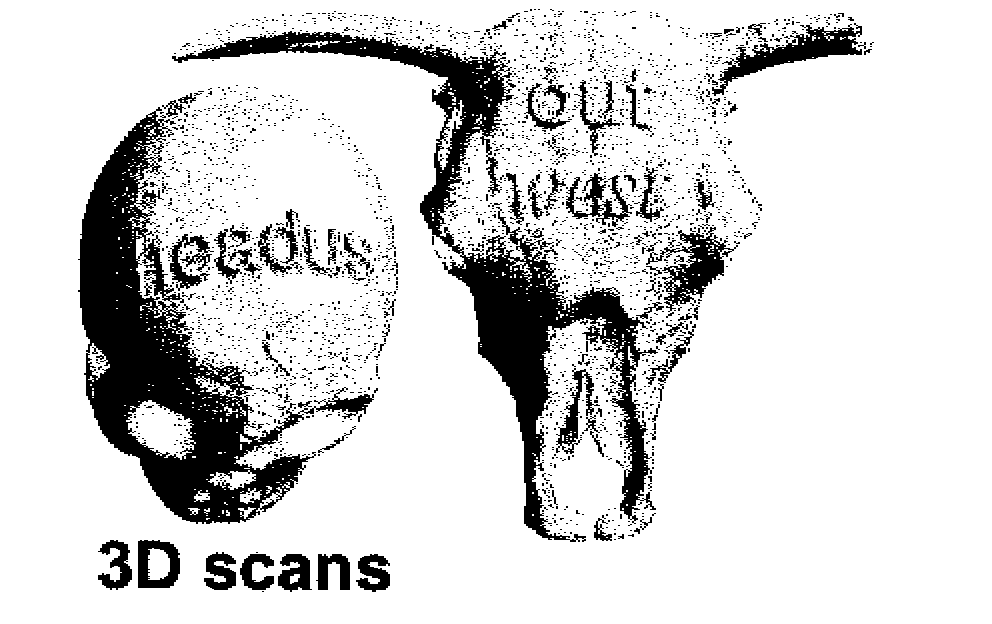

Chromeskin
Richie Kuhaupt & Geoffrey Drake-Brockman, 2001
 |
 |
|
|
Chromeskin
Chromium Plated Figure
|
Chromeskin
Realtime Generated Digital Image
|
Chromeskin is the result of a three year collaborative project between Richie Kuhaupt and Geoffrey Drake-Brockman. Chromeskin was a finalist in the 2001 inaugural National Sculpture Prize and Exhibition, and was on exhibition at the National Gallery of Australia in Canberra from November 30 2001 to March 10 2002. The work was awarded the distinction of Highly Commended by the National Sculpture Prize judges. Chromeskin will be exhibited in from August 2 to September 15 2002 at the John Curtin Gallery, Western Australia as part of the Bienale of Electronic Arts, Perth (BEAP). Kuhaupt and Drake-Brockman have previously exhibited the collaborative installation 'Geoffrey' at The Verge in 2001 and are currently developing a new project Lasercube for realisation in 2002/2003.
Chromeskin is an artwork that consists of two aspects - physical and virtual - arranged at counterpoise. Chrome is a null surface - a reflection that only quotes the world that it inhabits. Chrome is a cyberpunk reference symbol that signifies a technology-saturated world where 'street' culture is imbued with virtual and body-invasive supertechnologies. Chrome is the sanitised, smudge-free surface of the perfect housekeeper's pristine kitchen appliances. Chrome is an automotive effect from the heyday of American industrial dominance in the 50s and 60s when the automobile was celebrated as mechanical fetish and sexual extension. Chrome is a pop culture referent for supertechnology - the surface of the robot in Terminator II - the ultimate "liquid metal" machine.
The departure point for Chromeskin was a human bodycast. By a moulding process we created a hollow fibreglass casting that we used as a 'master' for subsequent stages of the project. This 'master' casting became the basis of two initially divergent paths:- One path entailed the preparation of a full size physical Chromeskin - a chromium plated, mirror finished, mannequin - via the use of electroforming and electroplating technology. First a layer of copper was electroformed over the fibreglass body elements in a plating bath. After polishing, layers of nickel and chromium were deposited to complete the surface. The process of chrome plating over a non-conductor was similar to that employed by Drake-Brockman in previous artworks.
 |
The other path, which we progressed in parallel, was the creation of a virtual Chromeskin 'inside the machine'. To achieve this, the master cast was surface-digitised by Headus Metamorphosis using a laser 3D scanner. Then, via 3D modeling software, the scan outputs were rendered to appear like chrome and the body was animated within virtual space. To fully express the virtual Chromeskin in an exhibition context we conceived of 'The Quadrascope'. Quadrascope is an omidirectional interface device that displays a large-scale animated version of Chromeskin on each side of a telephone box-sized rectangular prism. The device displays images derived from the Chromeskin laserscan data, processed against the current visual field around it. Observers are able to walk up to and around Quadrascope and approach its surfaces closely. On each face a representation of mirror surfaced Chromeskin is displayed, with the figure reflecting and reacting to the movements of the viewer in realtime. The device is a kind of 'fishtank' giving the impression of a chrome body floating within a rectangular volume. The machine uses four networked computers, four video cameras, and four 130cm plasma flat panel displays. Quadrascope is driven by synchronised 3-D rendering software written especially for the artists by headus (metamorphosis). |
Quadrascope enables a kind of reverse immersion experience, where an audience can walk around and into the presence of a participating digital other. By placing the virtual chrome-plated man inside the Quadrascope, and positioning it alongside the 'real' chrome-plated man, we have set the scene for a kind of collision between virtual and actual agents, which is played out with the audience as participants. All viewers are implicated in this work, it cannot be experience without a contribution into its feedback loops - both real and virtual. We hope that with this approach the work engages viscerally and is able to prompt a momentarily blurring of the boundary into a living, digitally synthesised, identity space. Physical Chromeskin acts as a projection of the virtual into the realworld. It is a kind of 'export' of a cyberterritory resident into a (relatively) low-tech' manifestation. Virtual Chromeskin, as realised via the Quadrascope, is a feedback loop back into the media from which the Chromeskin concept arose. The virtual and physical Chromeskin pair, exhibited together, offers a cross-border encounter by bringing the ultimate machine-concept-human face to face with an audience and permitting a strategic comparison to be made between realworld and screen-delimited interfaces technologies.
Geoffrey Drake-Brockman was born in Woomera, South Australia in 1964. In 1985 he obtained a BSc in Computer Science from the University of Western Australia, and in 1994 an MA (Visual Arts) from the Curtin University School of Art. He has been exhibiting since 1986 with a major solo exhibition 'The Identity Appliance' at Goddard de Fiddes in 1997. In 2001 he has exhibited at 'Sculpture by the Sea' in Sydney and installed the work 'Geoffrey' (in collaboration with R Kuhaupt) at The Verge, Perth. He was awarded the Sir Charles Gardiner Annual Art Award in 1993, and the 1997 AIIA Telstra AFR National Award for Excellence in Information Technology.
Richie Kuhaupt was born in Perth in 1960. He studied at the Curtin University of Technology, graduating in 1995 with an MA (Visual Arts). Kuhaupt has had six solo shows in Western Australia, and his works have been selected for numerous group exhibition including Sculpture by the Sea, Sydney in 1999 and 2000, Shaky Ground, Perth Institute of Contemporary Art, 1999, and Added Dimension, John Curtin Gallery, Perth. Kuhaupt has received a number of awards including the Sydney Water Sculpture Prize in 2000, and the City of Joondalup Invitation Art Award in 2000, and the Waverly Acquisitive Award, Sculpture by the Sea in 1999.
Kuhaupt and Drake-Brockman have been collaborating artistically since 1999. They are both based in Perth, Western Australia.
| Chromeskin 2001 | Chromeskin 2001 | Geoffrey 2001 | Geoffrey 2001 | Lasercube 2002 (with Skadada) |
 |
 |
 |
The artist acknowledge the support of the following individuals and agencies in the development of Chromeskin. The Perth Institute of Contemporary Arts. The State of Western Australia through ArtsWA in association with the Lotteries Commission, the Australia Council for the Arts. Jill Smith and Philip Dench of headus (metamorphis) Pty Ltd, who have been a major sponsor through their assistance with software development and systems integration services for the Quadrascope. NEC Australia for access to plasma display technology. Laurie Thompson of Premier Plating Co.
Contact: geoffrey@drake-brockman.com.au